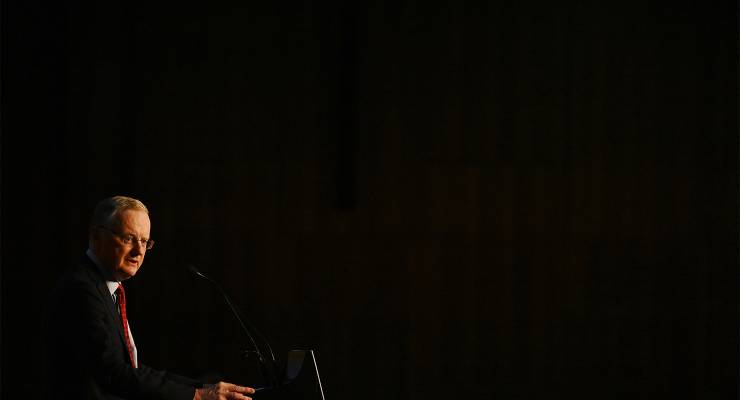
On Tuesday, the Reserve Bank of Australia (RBA) raised the official interest rate to 3.35%, reaching a 10-year high. It is the bank’s ninth rate rise since the cycle began in May last year.
Is this the top? Are we done? The answer is: probably. And if not, there’s likely to be only one or two more rate rises after this. We will get to an official interest rate of 3.6% or 3.85% and then pause.
The big question is what happens then. Will house prices pause too? Or will they keep tumbling as the reality of high-interest rates hits continues to dawn on borrowers? While share prices snap around, rising and falling 5% in a day’s trade, house markets are slow to adjust.
House prices are the tortoise
House prices fell about 1% in Sydney in December. That’s a fraction of the movements in the sharemarket, which fell 4%. Only a tiny fraction of housing stock changes hands each week. You can’t expect the market to adjust immediately.
Usually, instead of house prices snapping down in a weak market, volumes dry up. The number of homes sold has been well below usual levels recently. Sellers don’t want to sell in a down market and buyers are keen to wait to buy when prices bottom. So there’s a sort of truce, an uneasy standoff. One house on my street had a for sale sign for ages, but in the end the owners couldn’t find a buyer — tenants live there now.
The fast-adjusting part of the market is sales, not prices. But sales can’t be held down forever. Eventually sellers must accept that market prices are the new normal, and buyers must accept that prices are not going to fall much more — and houses must change hands.
When buyers and sellers all finally relent and return to the playing field, where will prices be?
One way to answer this is to look at lending. The banks were lending record amounts during the pandemic, when interest rates were at zero, as the next chart shows. As rates rise, that has to come down.
If we assume lending will return to pre-pandemic averages, then the market still has a way to go.
The hit to budgets
Imagine a young family with a budget for mortgage repayments of $3000 a month. They could afford to borrow $705,000 back when interest rates were 2%. With interest rates at 5.5%, they can borrow $487,000. That is a huge sum knocked off their purchase budget. If we assume they have a deposit of $200,000, instead of being able to spend $905,000 on a house, they can spend $687,000. A 24% fall.
Faced with a 10% fall in house prices and a 24% fall in their budget, such a buyer might be on the sidelines for now. Not many people have the emotional and cognitive flexibility to quickly lower their expectations for a house they want to buy. So it is no surprise we see first-home buyers making up less and less of the market, down by half since January 2021.
Of course, families like that are not the only kind of buyers. An upgrader planning to move from a $1 million home to a $2 million home and sees them both fall in price by 10% now needs to find an extra $900,000 to make the upgrade, not $1 million. That softens — but does not erase — the effect of rate rises.
Likewise, an investor hoping to pay off a rental property using rental income will also find the interest rate rise is softened, with rents up by 11% in capital cities over the past year, according to CoreLogic. (Although that’s not as much as the increase in mortgage repayments. Repayments go up 38% on a 25-year loan when rates rise from 2% to 5%.)
In each of these cases, the buyer must sit on the sidelines or lower their expectations.
Looking ahead
The market is not necessarily restored to balance the moment when rate rises stop. It may take longer for prices to fall to the point where demand recovers enough to meet supply. Timing is less important than the size of the price fall being enough to tempt buyers back to the market.
Note also that a bigger price fall will be needed if there are other pressures on repayment budgets, such as rising unemployment and continued falling real wages. If the RBA can somehow crush price rises without making unemployment worse, the housing market will recover after a smaller fall.
The major banks tip a total house price fall in the high teens, about 18% top to bottom. They expect the bottom to be later this year.
But when prices start rising again, sellers will be keen to move too so they can make their replacement purchase before prices rise too far. Any rise in prices should bring activity back to the market, but of course that doesn’t guarantee price rises.
A long period of stasis is actually possible in housing markets, as anyone who owned a house in the 1990s will be able to attest.








“Imagine a young family with a budget for mortgage repayments of $3000 a month. They could afford to borrow $705,000 back when interest rates were 2%. With interest rates at 5.5%, they can borrow $487,000.”
Surely a bank would factor in possible interest rate rises into the calculation of how much money they would lend?
If not, were people being loaned too much money for houses?
Judging by the absurdly high prices of residential property and Australia’s very high position (fourth or fifth?) on the international scale of household debt (averaging over 200% of net household yearly income), the answer is yes.
The short answer is no they are not being loaned too much money per se however it is complicated.
Loan applications are assessed on a number of criteria :
– Current and past employment and living arrangements.
– Past loan history – both approved and declined loans.
– The length of time taken to repay any loans and any defaults or missed payments they may have had, as well as any bad debts or judgements.
– The number of credit enquiries made and over what timeframe.
– The deposit
The property being purchased is also assessed by a Valuer to determine if the the price is above market value.
Let’s just say that it’s not unheard of for would be borrowers to “underestimate” their expenditure. You also need to understand that HL applications are completed at a point in time and that people’s circumstances change over time. They may have purchased a car afterwards etc etc.
In the early days of a loan, interest rate increases have a much greater impact than after the loan has been paid down. People tend to only make the minimum payments rather than paying as though the loan was at a much higher interest rate. Frequently, first time homeowners purchase with absolutely no buffer in reality however on paper they are fine.
It’s also not unheard of for “Valuers” (paid for and selected by the Bank) to always come up with a “Valuation” that coincides with the Bank’s lending figure……………..
Strangely enough, any “Valuer” who gets it wrong too may times gets mysteriously dropped from the authorized list.
Australian Banks are not real Banks – just overblown Building Societies.
Their core game plan is predicated on continuously rising house prices ………….
Yes ! For twenty-odd years now. This is a fundamental part of the problem.
House prices would look a lot different if mortgages had remained limited to 3-4x household income.
How do you find economic democracy without getting Argentina’d? The people are addicted to the circuses, they’re no help. In the meantime I’ve got to read these comments about the details of loan applications. The really awful thing about hell is the boredom of engaging with it. You all bore me.
I can’t much fault this post. Light on detail but I can’t see any inaccuracy.
Speaking from outside the east coast bubble, I see no sign of house price falls in Adelaide, at least not at the lower end where first time buyers mostly try to buy
Time for Labor to sack Phil Lowe and the RBA Board. At the least
Why?………..
……….the RBA has been telling “government” since his predecessor was in the hot seat that interest rates could no longer do the job and that government action was required.
All the action the previous “government” took was diametrically opposed to what the RBA was trying to do.
i.e. the RBA was trying to pump money INTO the economy, while the “government” was trying to suck it OUT………..
…………….all to back up their fantasy “Back In The Black” ideology.
That’s where the 14 consecutive rate CUTS came from…………..
…….and I didn’t hear any bleating about that at the time.
Now imagine what happens if you remove all the incentives for investors purchasing established housing. Investors will seek ways around but if you do it well, most will be pushed to invest in new housing, increasing or improving supply, while reducing demand in the established market, both changes putting downward pressure on house prices. Who loses, not single home owners whose gains are on paper and if they sell must also buy and do so on the same market. Not most investors really, they just get less of a still very large profit if they bought more than three years ago. So recent, or over leveraged or greedy investors will scream. Real estate agents who profit from turnover might, though if it gets a market reset and turnover moving, perhaps not more than their usual knee jerk, we’ll all be ruined. Lots of winners among home buyers and builders and associated trades. Mostly a win. But with a majority of politicians being housing investors such a policy may not appeal, it certainly hasn’t so far.